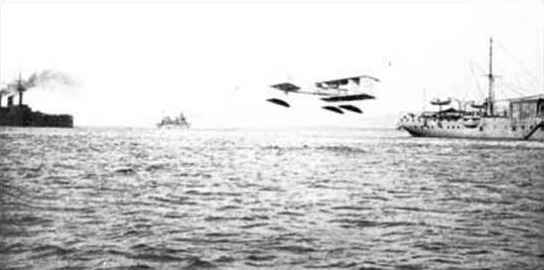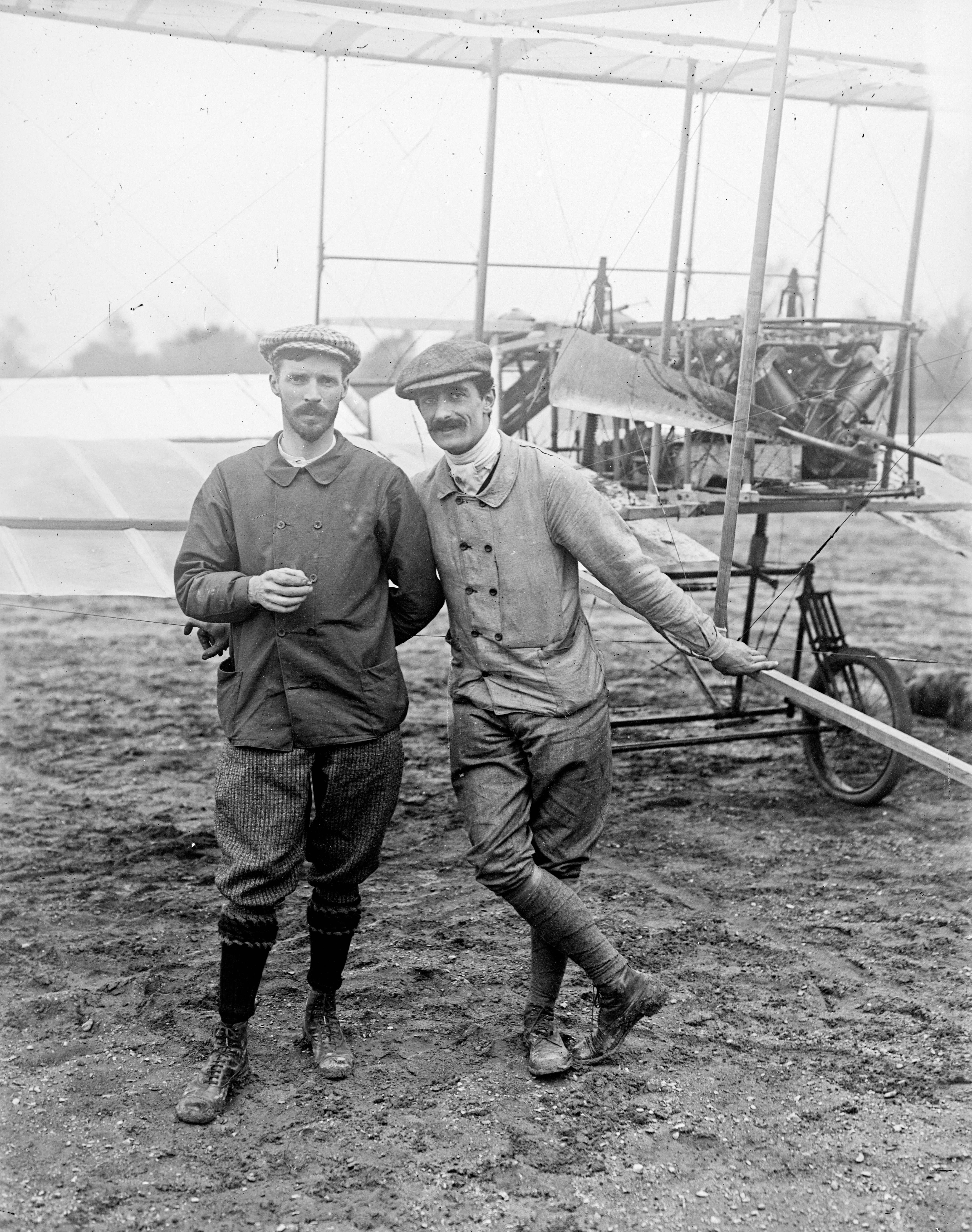|
Fabre Hydravion
Fabre Hydravion is the name used in English-language sources for an originally unnamed experimental floatplane designed by Henri Fabre. The aircraft is notable as the first to take off from water under its own power. Development Hydravion (French for seaplane/floatplane) was developed over a period of four years by Fabre, assisted by a former mechanic of Captain Ferdinand Ferber, named Marius Burdin, and Léon Sebille, a naval architect from Marseilles. Fabre did not initially name his machine, which in contemporary reports was referred to as an "aéroplane marin", but it subsequently came to be referred to in English common usage by the French term for the type of craft. The aircraft was a canard configuration monoplane whose structure made extensive use of a beam design working as a spanwise spar on its wing panels and forward canard surface, patented by Fabre. This was a Warren truss girder with all members having a streamlined section. Two of these beams, one above th ... [...More Info...] [...Related Items...] OR: [Wikipedia] [Google] [Baidu] |
Floatplane
A floatplane is a type of seaplane with one or more slender floats mounted under the fuselage to provide buoyancy. By contrast, a flying boat uses its fuselage for buoyancy. Either type of seaplane may also have landing gear suitable for land, making the vehicle an amphibious aircraft. British usage is to call "floatplanes" "seaplanes" rather than use the term "seaplane" to refer to both floatplanes and flying boats. Use Since World War II and the advent of helicopters, advanced aircraft carriers and land-based aircraft, military seaplanes have stopped being used. This, coupled with the increased availability of civilian airstrips, have greatly reduced the number of flying boats being built. However, numerous modern civilian aircraft have floatplane variants, most of these are offered as third-party modifications under a supplemental type certificate (STC), although there are several aircraft manufacturers that build floatplanes from scratch. These floatplanes have found t ... [...More Info...] [...Related Items...] OR: [Wikipedia] [Google] [Baidu] |
Canard (aeronautics)
In aeronautics, a canard is a wing configuration in which a small forewing or foreplane is placed forward of the main wing of a fixed-wing aircraft or a weapon. The term "canard" may be used to describe the aircraft itself, the wing configuration, or the foreplane.. Canard wings are also extensively used in guided missiles and smart bombs. The term "canard" arose from the appearance of the Santos-Dumont 14-bis of 1906, which was said to be reminiscent of a duck (''canard'' in French) with its neck stretched out in flight. Despite the use of a canard surface on the first powered aeroplane, the Wright Flyer of 1903, canard designs were not built in quantity until the appearance of the Saab Viggen jet fighter in 1967. The aerodynamics of the canard configuration are complex and require careful analysis. Rather than use the conventional tailplane configuration found on most aircraft, an aircraft designer may adopt the canard configuration to reduce the main wing loading, to bet ... [...More Info...] [...Related Items...] OR: [Wikipedia] [Google] [Baidu] |
Marignane
Marignane (; oc, Marinhana) is a commune in the Bouches-du-Rhône department in the Provence-Alpes-Côte d'Azur region in southern France. Geography It is a component of the Aix-Marseille-Provence Metropolis, and the largest suburb of the city of Marseille. It is located 18.3 km (11.4 mi) to the northwest of Marseille. Climate The climate is hot-summer mediterranean ( Köppen: ''Csa''). The city serves as the basis for data from Marseille through the weather station at the airport, which is inside Marignane's city limits. History In the 15th century the Count of Provence owned the land, and from 1603 to the French Revolution it belonged to the Covets. In the 17th century the Covets refurbished the castle. Three chapels and one convent were built in the 17th and 18th century: ''Notre-Dame de Pitié'' (1635), ''Saint-Nicolas'' (1695), ''Sainte-Anne'' (1710, now demolished), and ''Couvent des Minimes'' (1695). Population Politics From 1995 to 2008, the may ... [...More Info...] [...Related Items...] OR: [Wikipedia] [Google] [Baidu] |
Marseille Provence Airport
Marseille Provence Airport () is an international airport located 27 km (17 miles) northwest of Marseille, on the territory of Marignane, both '' communes'' of the Bouches-du-Rhône '' département'' in the Provence-Alpes-Côte d'Azur '' région'' of France. The airport's hinterland goes from Gap to Arles and from Toulon to Avignon. History Formerly known as ''Marseille–Marignane Airport'', it has been managed since 1934 by the Marseille-Provence Chamber of Commerce and Industry (CCI). In the 1920s and 1930s, Marignane was one of France's main points of operation for flying boats. It even briefly served as a terminal for Pan American World Airways ''Clipper'' flying boats. Other flying boat operators were Aéropostale and Air Union, the latter moving over from Antibes in 1931. Marignane was also a production site for hydroplanes by Lioré et Olivier. Antoine de Saint-Exupery describes turning back to Marignane airport with a fuel leak in chapter 8 of '' ... [...More Info...] [...Related Items...] OR: [Wikipedia] [Google] [Baidu] |
Hydroaéroplane Caudron-Fabre
The Hydroaéroplane Caudron-Fabre, (Caudron-Fabre), was a French amphibious seaplane that competed in the 1912 Monaco event. It was one of the first true amphibians, able to take-off from water and touch down on land. Design and development On 28 March 1910, the Frenchman Emile Fabre made the first successful take-off from and landing on water. His float design was the first to allow an aircraft to break away from the surface and was patented. Its success attracted the interest of most of the major French aircraft builders, who saw new possibilities for aviation opening up. Glenn Curtiss bought a licence to build them. These aviators included René Caudron, who combined Fabre's floats with a new aeroplane design that retained many of the characteristics of his Type B.2, Type C, Type D and Type E unequal span two bay biplanes. The wings of the Caudron-Fabre were particularly similar to those of the B2 and D2, rectangular in plan, apart from slightly angled tips, equal chord an ... [...More Info...] [...Related Items...] OR: [Wikipedia] [Google] [Baidu] |
Caudron
The Société des Avions Caudron was a French aircraft company founded in 1909 as the Association Aéroplanes Caudron Frères by brothers Gaston and René Caudron. It was one of the earliest aircraft manufacturers in France and produced planes for the military in both World War I and World War II. From 1933 onwards, it was a subsidiary of Renault. Alphonse (Gaston) (1882–1915) and René Caudron (1884–1959) Born in Favières, Somme to parents who farmed nearby in Romiotte, the Caudron brothers were educated at a college in Abbeville. Gaston, as Alphonse was always known, intended to become an engineer but his education was cut short by health problems; René was interested in the development of mechanics and was a sportsman. After military service in an artillery regiment, they returned to work on the farm. They began to build their first aircraft, a large biplane, in August 1908. Initially unable to obtain an engine, they flew it as a glider, towed by a horse, and tested it th ... [...More Info...] [...Related Items...] OR: [Wikipedia] [Google] [Baidu] |
Flight International
''Flight International'' is a monthly magazine focused on aerospace. Published in the United Kingdom and founded in 1909 as "A Journal devoted to the Interests, Practice, and Progress of Aerial Locomotion and Transport", it is the world's oldest continuously published aviation news magazine. ''Flight International'' is published by DVV Media Group. Competitors include Jane's Information Group and '' Aviation Week''. Former editors of, and contributors include H. F. King, Bill Gunston, John W. R. Taylor and David Learmount. History The founder and first editor of ''Flight'' was Stanley Spooner. He was also the creator and editor of ''The Automotor Journal'', originally titled ''The Automotor Journal and Horseless Vehicle''.Guide To British Industrial History: Biographies: ' ... [...More Info...] [...Related Items...] OR: [Wikipedia] [Google] [Baidu] |
Voisin Canard
The Voisin Canard was an aircraft developed by Voisin brothers during 1910 and first flown early in 1911. It was named the ''Canard'' because of the resemblance of its forward fuselage to that of a duck's long neck while in flight. It was originally flown as a landplane: with the addition of floats it became one of the first seaplanes used by the French Navy. Design and development The Canard was, even by the standards of 1910, a curiously regressive design, its layout reminiscent of Alberto Santos-Dumont's 14-bis of 1906. As first flown at Issy-les-Moulineaux by Maurice Colliex, the aircraft had an uncovered fuselage of wire-braced wood construction with the Rossel-Peugeot rotary engine at the rear and the front-mounted control surfaces consisting of an all-moving elevator divided into two halves, one either side of the fuselage, a rectangular balanced rudder mounted above the elevator, and a pair of short-span fixed horizontal surfaces with a high angle of attack mounted be ... [...More Info...] [...Related Items...] OR: [Wikipedia] [Google] [Baidu] |
Charles Voisin
Charles Voisin (12 July 1882 in Lyon – 26 September 1912 in Belleville-sur-Saône) was an early aviation pioneer from France. He was the younger brother of Gabriel Voisin, also an aviation pioneer. Biography Charles joined his brother in 1906 and the ''Appareils d'Aviation Les Frères Voisin'' ("Voisin Brothers' Flying Machines") was formed. Their first successful plane was built in 1907. This machine, a pusher biplane powered by an Antoinette engine, was built for Leon Delagrange and was tested by Charles in February–April before being handed over to him. The first powered flight was made on 16 March 1907, when Charles flew for 10 metres at Neuilly-Bagatelle. Voisins' aircraft became a significant advance in the aviation history. Record breaking flier Henri Farman flew a Voisin pusher biplane in most of his early flights, notably so when he became first in Europe to successfully complete a 1 km closed circuit at Issy-les-Moulineaux Issy-les-Moulineaux () is a ... [...More Info...] [...Related Items...] OR: [Wikipedia] [Google] [Baidu] |
Gabriel Voisin
Gabriel Voisin (5 February 1880 – 25 December 1973) was a French aviation pioneer and the creator of Europe's first manned, engine-powered, heavier-than-air aircraft capable of a sustained (1 km), circular, controlled flight, which was made by Henry Farman on 13 January 1908 near Paris, France. During World War I the company founded by Voisin became a major producer of military aircraft, notably the Voisin III. Subsequently, he switched to the design and production of luxury automobiles under the name Avions Voisin. Early life Gabriel Voisin was born on 5 February 1880 in Belleville-sur-Saône, France, and his brother Charles Voisin, two years younger than him, was his main childhood companion. When his father abandoned the family his mother, Amélie, took her sons to Neuville-sur-Saône, where they settled near her father's factory. Their grandfather, Charles Forestier, took charge of the boys' education with military rigor. The boys also went for expeditions alon ... [...More Info...] [...Related Items...] OR: [Wikipedia] [Google] [Baidu] |
Bouches-du-Rhône
Bouches-du-Rhône ( , , ; oc, Bocas de Ròse ; "Mouths of the Rhône") is a department in Southern France. It borders Vaucluse to the north, Gard to the west and Var to the east. The Mediterranean Sea lies to the south. Its prefecture and largest city is Marseille; other important cities include Aix-en-Provence, Arles, Martigues and Aubagne. Marseille, France's second-largest city, has one of the largest container ports in the country. It prizes itself as France's oldest city, founded by Greek settlers from Phocaea around 600 BC. Bouches-du-Rhône is the most populous department of the Provence-Alpes-Côte d'Azur region, with 2,043,110 inhabitants as of 2019.Populations légales 2019: 13 Bouches-du-Rhône INSEE It has an area of . Its [...More Info...] [...Related Items...] OR: [Wikipedia] [Google] [Baidu] |

.jpg)
_(9256079273).jpg)





